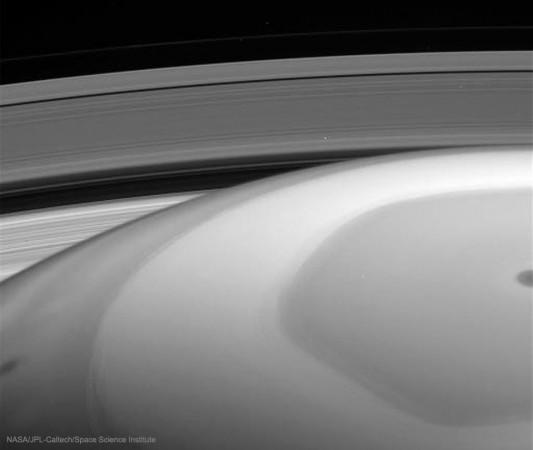
As NASA's Cassini spaceraft continues with the Grand Finale mission, it closely scooped through Saturn's atmosphere. NASA has lately released a video portraying photos of the ringed planet and the image of the ring the spacecraft captured on April 26.
Also Read: NASA's Chandra X-ray Observatory discovers a giant hot wave in the Perseus galaxy [VIDEO]
The movie reveals a hour-long journey of the craft while it analysed Saturn moving southwards. The video shows the swirling vortex present on the north pole of Saturn, it also shows the outer boundary of the hexagon-shaped jet stream which is located around 78°N and beyond.
"I was surprised to see so many sharp edges along the hexagon's outer boundary and the eye-wall of the polar vortex," said Kunio Sayanagi -- an associate of the Cassini imaging team based at Hampton University in Virginia, who helped produce the new movie, a NASA statement revealed.
"Something must be keeping different latitudes from mixing to maintain those edges," he added.

The camera frame rotates towards the end of the movie Cassini reorients and the huge, saucer-shaped antenna can be seen in the direction of its motion. The saucer-shaped antenna was equipped by the mission managers in order to shield the spacecraft from the debris present in the gap between the planet and its rings during its dives.
Cassini had lowered its altitude from a distance of 72,400 to 6,700 kilometers (45,000 to 4,200 miles) while the frames for the flick were being captured.
The camera resolution of the spacecraft was improved; the smallest resolvable features in the atmosphere changed from 8.7 kilometers (5.4 miles) per pixel to 810 meters (0.5 mile) per pixel.
"The images from the first pass were great, but we were conservative with the camera settings. We plan to make updates to our observations for a similar opportunity on June 28 that we think will result in even better views," said Andrew Ingersoll, a member of the Cassini imaging team based at Caltech in Pasadena, California, as quoted by the NASA statement.
Have a look at the first flyby past Satrun by NASA's Cassini spacecraft here:












!['Had denied Housefull franchise as they wanted me to wear a bikini': Tia Bajpai on turning down bold scripts [Exclusive]](https://data1.ibtimes.co.in/en/full/806605/had-denied-housefull-franchise-they-wanted-me-wear-bikini-tia-bajpai-turning-down-bold.png?w=220&h=138)
![Nayanthara and Dhanush ignore each other as they attend wedding amid feud over Nayanthara's Netflix documentary row [Watch]](https://data1.ibtimes.co.in/en/full/806599/nayanthara-dhanush-ignore-each-other-they-attend-wedding-amid-feud-over-nayantharas-netflix.jpg?w=220&h=138)



